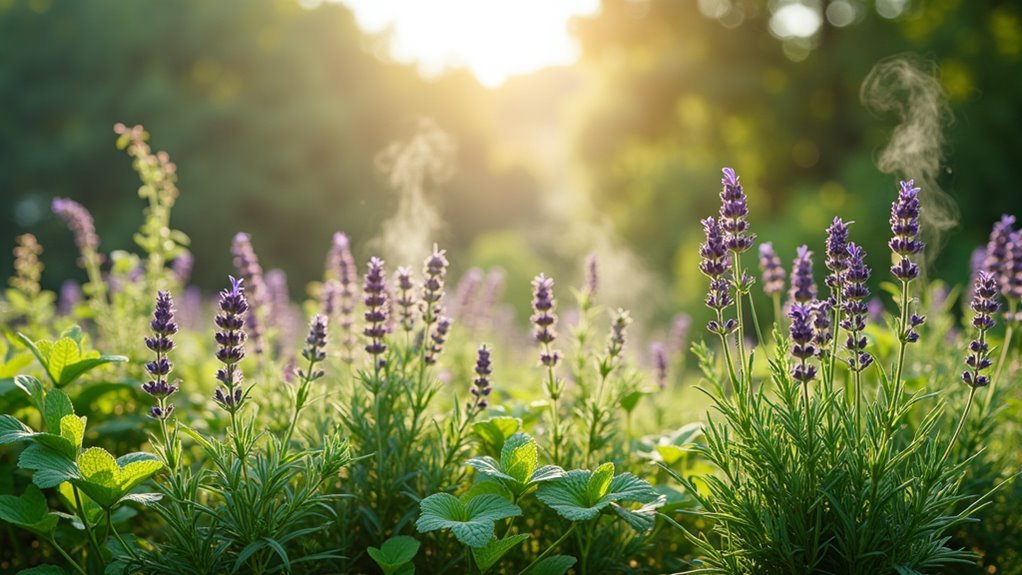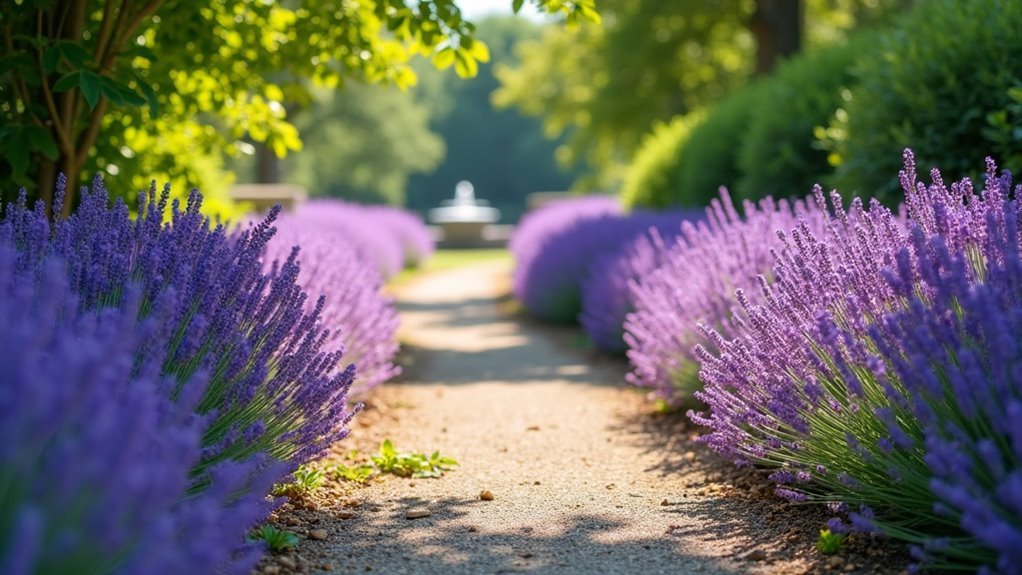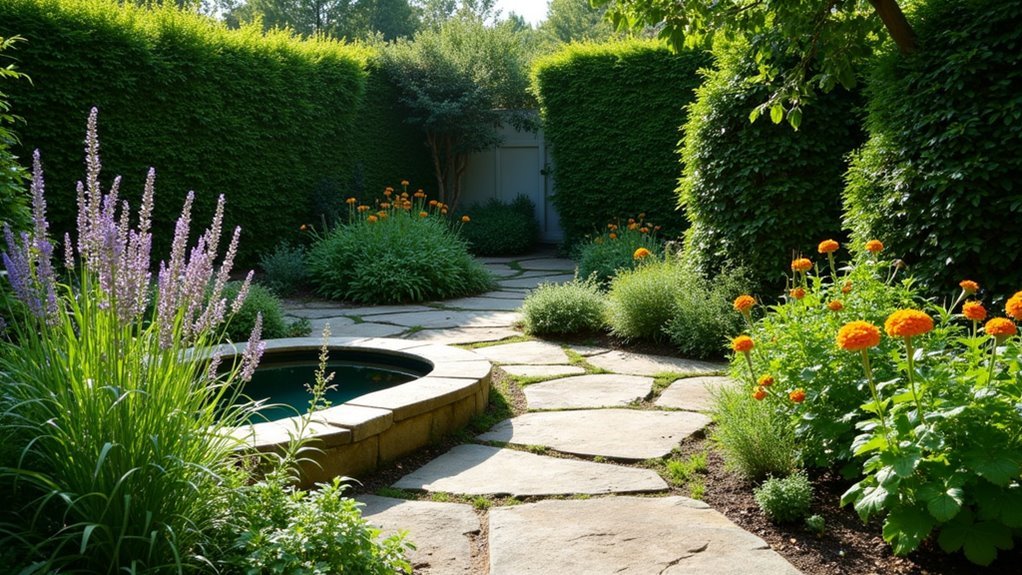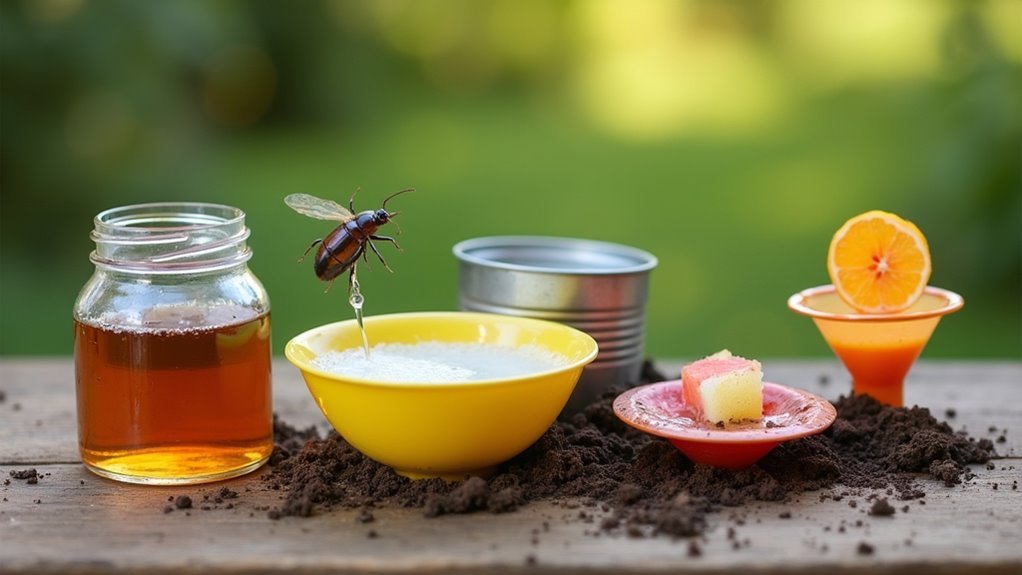You can create effective mosquito-repelling landscapes by implementing strategic plant combinations and layered defense systems. Position taller plants like citronella grass and bee balm at garden perimeters, while using shorter plants such as catmint and basil as front fillers. Line pathways with lavender and marigolds for targeted protection, and incorporate companion plantings that enhance both mosquito control and garden health. Eliminate standing water sources and maintain regular pruning schedules. These proven design principles will help you discover thorough solutions for lasting outdoor protection.
Fragrant Herb Garden Borders

When you’re designing a mosquito-repelling landscape, fragrant herb garden borders offer one of the most practical and beautiful solutions available.
You’ll find that planting lavender, basil, and rosemary along your garden’s perimeter creates an aromatic barrier that naturally deters mosquitoes and other pests. For enhanced mosquito repelling effectiveness, incorporate catmint, which proves ten times more potent than DEET, alongside mint varieties that also attract beneficial insects.
These fragrant herbs serve dual purposes—you can harvest basil and rosemary for cooking while maintaining pest control.
Mix perennial options like sage with annual marigolds to guarantee continuous blooms from early summer through frost.
Strategic placement and regular maintenance maximize your herb border’s effectiveness, creating a vibrant landscape that’s both functional and visually appealing.
Citronella Grass Perimeter Plantings
Building on your herb border foundation, citronella grass perimeter plantings create an even more formidable defense against mosquitoes while adding dramatic tropical appeal to your landscape.
You’ll want to position this lemon grass around patios, decks, and garden bed edges where its distinct scent works overtime for mosquito control.
Plant it in sunny spots within large planters for maximum effectiveness in USDA zones 9-11, treating it as an annual elsewhere.
When you brush against the leaves, they’ll release essential oils that outperform many chemical repellents.
This low-maintenance perimeter strategy doesn’t just keep pests away—it transforms your outdoor space into an attractive tropical oasis that’s both beautiful and functional.
Lavender Pathway Installations

You’ll need to plan your lavender pathway installation carefully, considering both the visual impact and mosquito-repelling effectiveness you want to achieve.
Proper spacing between plants guarantees healthy growth while maximizing the fragrant barrier that keeps pests at bay.
Understanding the maintenance requirements upfront will help you create a stunning, low-maintenance pathway that provides natural mosquito protection for years to come.
Pathway Design Considerations
Since lavender’s natural mosquito-repelling properties make it perfect for pathway borders, you’ll want to plan your installation carefully to maximize both its protective benefits and visual appeal.
These fragrant plants create an effective barrier while adding stunning purple blooms to your landscape design.
Consider these key factors when designing your lavender pathway:
- Spacing requirements – Position plants 18-24 inches apart for ideal growth and continuous mosquito protection
- Sunlight exposure – Select areas receiving 6-8 hours of direct sunlight daily for healthiest development
- Drainage systems – Guarantee well-draining soil conditions to prevent root rot and maintain plant vigor
- Pathway width – Create borders wide enough to accommodate mature plant spread while maintaining walkable space
Proper planning guarantees your lavender pathway delivers long-lasting mosquito control with minimal maintenance requirements.
Lavender Spacing Guidelines
Proper spacing forms the foundation of a successful lavender pathway installation. You’ll want to space your lavender plants 12 to 18 inches apart to guarantee adequate air circulation and prevent mold and disease issues. This spacing allows each plant room to reach its full potential while maintaining the dense appearance you’re after for mosquito control.
Choose a location that receives 6 to 8 hours of direct sunlight daily, as lavender thrives in full sun conditions.
Focus on drainage by elevating your planting area or amending soil with sand or gravel. Select varieties suited to your USDA hardiness zone (5-11) for best results.
Remember to prune annually after flowering to maintain shape and encourage vigorous new growth.
Maintenance and Care
Once your lavender pathway is established, maintaining these hardy plants becomes remarkably straightforward. The drought-resistant nature of lavender means you’ll spend minimal time watering, while still enjoying effective mosquito-repelling benefits along your walkway.
Your maintenance routine should include:
- Pruning after flowering to maintain shape and encourage new growth for continued fragrance
- Watering sparingly once plants are established, as lavender prefers dry conditions
- Monitoring plant spacing to guarantee adequate air circulation and prevent overcrowding issues
- Removing weeds around the base to maintain the pathway’s clean appearance
Regular pruning is essential for keeping your lavender healthy and maximizing its mosquito-repelling properties.
The fragrant oils released through proper maintenance will continue providing pleasant aromas while naturally deterring unwanted insects throughout the growing season.
Strategic Water Feature Placement

While water features can attract mosquitoes if poorly planned, you’ll find they become powerful allies in your mosquito-repelling landscape when positioned strategically.
The key is eliminating standing water while maintaining movement through fountains, waterfalls, or aerated ponds. Install filtration systems that keep water circulating constantly, since mosquitoes won’t lay eggs in moving water.
Moving water is your secret weapon—mosquitoes refuse to lay eggs where currents flow, making fountains and waterfalls natural deterrents.
Position your strategically placed water features where they’ll create cross-breezes and air circulation throughout your yard.
Add aquatic plants like water lilies to attract beneficial insects that devour mosquito larvae. Surround these features with mosquito-repelling plants such as citronella grass and lavender for additional protection.
Regular cleaning and maintenance prevents stagnation. Change water weekly in smaller features and guarantee pumps function properly to maintain that vital water movement.
Marigold Container Arrangements
Marigolds transform ordinary patios and entryways into vibrant mosquito-deterrent zones when you arrange them strategically in containers.
These easy-to-grow annuals serve double duty as natural mosquito repellent and colorful landscape features, blooming continuously from late spring until frost.
Position marigold containers near seating areas and doorways to maximize their pest-repelling benefits while adding visual appeal. They’ll effectively deter mosquitoes, aphids, thrips, and whiteflies from your outdoor spaces.
For ideal mosquito repellent effectiveness:
- Mix French, Mexican, and African marigold varieties for diverse colors and enhanced pest control
- Use quality potting soil with proper drainage in full-sun locations
- Deadhead spent flowers regularly to encourage continuous blooming
- Group multiple containers at varying heights for maximum visual impact and coverage
Mixed Repellent Plant Groupings
You’ll achieve maximum mosquito protection by combining multiple repellent plants rather than relying on single species scattered throughout your landscape.
Creating layered defense systems with different plant heights and bloom times guarantees consistent coverage while addressing varying mosquito activity patterns.
You can maintain year-round protection through seasonal planting rotations that account for each plant’s growing cycle and peak repellent effectiveness.
Strategic Plant Combinations
When you combine multiple mosquito-repelling plants in strategic plant combinations, you’ll create powerful natural barriers that outperform single-species plantings.
These thoughtfully designed groupings maximize pest control effectiveness while adding visual appeal to your landscape.
Strategic plant combinations offer multiple benefits for thorough mosquito deterrence:
- Layered defense systems – Mix catmint with rosemary and basil for up to ten times more effectiveness than DEET-based repellents.
- Fragrant barrier borders – Combine lavender, marigold, and citronella grass around patios and entryways for enhanced protection.
- Year-round coverage – Pair annual floss flowers with perennial sage and allium for continuous seasonal control.
- Biodiversity promotion – Plant bee balm with mint to attract beneficial insects while repelling pests.
These combinations create multi-functional landscapes that protect your outdoor spaces naturally.
Layered Defense Systems
Creating layered defense systems with mixed repellent plant groupings transforms your garden into a fortress against mosquitoes through strategic vertical and horizontal arrangements.
You’ll establish multiple barriers by clustering lavender, marigolds, and citronella grass together, creating concentrated zones of protection that work more effectively than individual plants.
Mix perennial catmint and bee balm with annual varieties to maintain year-round mosquito control across seasons.
Position these companion plants near your vegetables and flowers to simultaneously deter pests while attracting beneficial insects that support garden health.
Include aromatic herbs like basil and rosemary in your design for dual-purpose functionality—they’ll repel mosquitoes while providing fresh ingredients for cooking.
Maintain these groupings regularly since healthy plants release stronger essential oils, ensuring maximum repelling power throughout the growing season.
Seasonal Planting Rotations
Strategic seasonal planting rotations amplify your layered defense approach by timing specific plant combinations to match mosquito activity patterns throughout the year.
You’ll create continuous protection by mixing annuals and perennials that bloom at different times, ensuring no gaps in your natural barrier.
Your seasonal planting rotations should incorporate these mosquito-repelling plants:
- Spring setup: Plant marigolds and basil as temperatures warm, establishing early-season protection.
- Summer combinations: Group bee balm with thriving basil to maximize mid-season coverage.
- Perennial anchors: Use lavender and rosemary as year-round foundations that support rotating annuals.
- Companion clusters: Pair citronella grass with mint and sage to create diverse, effective deterrent zones.
This rotation strategy disrupts mosquito breeding cycles while maintaining overlapping blooming periods for consistent natural repellent coverage.
Drainage-Focused Garden Beds
Since stagnant water serves as the primary breeding ground for mosquitoes, designing garden beds with perfect drainage becomes your most effective defense against these persistent pests.
Drainage-focused garden beds eliminate standing water where mosquito larvae develop into biting adults. You’ll want to implement raised beds with sloped designs that channel excess water away efficiently. Plant mosquito-repelling herbs like lavender and rosemary, which thrive in well-drained conditions while adding natural protection.
| Garden Bed Feature | Mosquito Control Benefit |
|---|---|
| Raised elevation | Prevents water pooling |
| Sloped design | Directs water runoff |
| Improved soil composition | Enhances drainage speed |
| Strategic plant selection | Natural mosquito deterrent |
| Proper air circulation | Hostile larvae environment |
Regular monitoring and soil adjustments maintain perfect drainage, keeping your outdoor spaces mosquito-free throughout the season.
Rosemary and Sage Cooking Gardens
You’ll create an effective dual-purpose space by designing cooking gardens that feature rosemary and sage as natural mosquito deterrents.
These aromatic herbs don’t just repel unwanted insects—they’ll provide you with fresh ingredients that enhance your culinary creations throughout the growing season.
Strategic placement of these perennial herbs in full-sun locations with proper drainage maximizes both their pest-control properties and harvest potential.
Garden Layout Planning
When planning your cooking garden layout, rosemary and sage should anchor your design as they deliver powerful mosquito-repelling properties while supplying fresh ingredients for your kitchen.
Your garden design becomes both functional and beautiful when you strategically position these herbs near outdoor spaces where you’ll benefit most from their good mosquito control abilities.
Here’s how to optimize your layout:
- Position rosemary in full sun areas with excellent drainage, especially hot, dry spots where it’ll thrive.
- Place sage near patios and dining areas where you can burn it for enhanced mosquito protection.
- Create companion clusters with basil and bee balm alongside your rosemary and sage.
- Shape rosemary into decorative forms through pruning to enhance your garden’s visual appeal.
Mosquito Repelling Properties
The aromatic oils in rosemary and sage create a natural defense system that mosquitoes can’t tolerate. When you brush against these herbs or burn their foliage, they release powerful scents that effectively repel pests while enhancing your outdoor cooking experience. Your herb garden becomes a dual-purpose space that provides fresh flavors and mosquito control.
| Herb | Mosquito Control Method |
|---|---|
| Rosemary | Disturbed foliage releases oils |
| Sage | Burning creates earthy deterrent |
| Rosemary | Thrives in hot, dry conditions |
| Sage | Effective near fire pits |
Regular pruning strengthens their aromatic properties and promotes healthy growth. These perennials offer year-round protection in suitable zones, creating fragrant barriers that let you enjoy outdoor spaces without constant insect interference.
Culinary Harvest Benefits
Beyond their pest control benefits, rosemary and sage transform your outdoor space into a productive culinary garden that supplies fresh herbs year-round.
These dual-purpose perennials thrive in full sun and well-drained soil, making them perfect companions for functional landscaping.
You’ll enjoy multiple advantages when incorporating these repelling herbs into your cooking gardens:
- Year-round availability – Rosemary grows in zones 7-10 while sage flourishes in zones 5-8
- Enhanced outdoor dining – Natural mosquito deterrent improves your patio meal experiences
- Decorative versatility – Rosemary can be pruned into attractive shapes for visual appeal
- Aromatic cooking enhancement – Sage’s fragrant aroma when burned elevates your culinary preparations
You’re fundamentally creating a beautiful, pest-free outdoor kitchen garden that delivers fresh flavors while naturally repelling mosquitoes from your entertaining spaces.
Catmint Ground Cover Systems
Among all natural mosquito deterrents, catmint stands out as remarkably effective ground cover that’s ten times more potent than DEET. This hardy perennial thrives in zones 3-8, delivering continuous protection against insect pests from early summer through fall while creating stunning visual appeal with blue-purple blooms.
You’ll appreciate catmint’s low-maintenance nature as it adapts to various soil conditions and requires minimal care once established. The fragrant foliage naturally repels mosquitoes while attracting beneficial pollinators like bees and butterflies, creating balanced garden ecosystems.
Though catmint spreads aggressively, you can easily manage its growth through regular pruning. This containment strategy lets you harness its mosquito-repelling properties without allowing it to overtake neighboring plants, making it perfect for strategic landscape placement.
Multi-Level Mosquito Defense Zones
Building on catmint’s impressive defense capabilities, you can amplify mosquito protection by creating multi-level defense zones that strategically layer repelling plants throughout your landscape.
These design ideas maximize mosquito control by establishing thorough barriers that work together seamlessly.
Your multi-level approach should include:
- Back barriers – Position taller plants like citronella grass and bee balm at garden bed perimeters.
- Front fillers – Use shorter plants such as catmint and basil to complete ground-level coverage.
- Pathway protection – Line walkways and seating areas with lavender and marigolds for targeted defense.
- Companion combinations – Pair marigolds with vegetables to deter mosquitoes while promoting healthier crops.
Consider varied sunlight exposure when designing zones, ensuring each plant receives ideal growing conditions.
Regular maintenance, including pruning and eliminating standing water, keeps your defense system functioning effectively.
Frequently Asked Questions
What Landscaping Deters Mosquitoes?
You’ll deter mosquitoes by planting lavender, marigolds, and citronella grass near patios and entryways. Eliminate standing water, use diverse plant selections, and apply companion planting techniques like pairing basil with tomatoes for effective control.
What Is the Best Outdoor Plant to Keep Mosquitoes Away?
You’ll find catmint’s your best choice since it’s ten times more effective than DEET at repelling mosquitoes. It’s hardy, blooms all summer through fall, and thrives in zones 3-8.
What Is the Most Effective Mosquito Repellent for the Yard?
You’ll find catmint is your most effective yard mosquito repellent, being ten times more powerful than DEET. Plant it strategically near patios and entrances to create natural barriers that’ll considerably reduce mosquito populations.
What Did Native Americans Use to Repel Mosquitoes?
You’d burn sage, cedar, and sweetgrass to create mosquito-deterring smoke. You’d crush bee balm leaves and apply them to your skin, while using mint and lavender oils for natural protection against bites.
In Summary
You’ve got powerful tools to reclaim your outdoor space from mosquitoes. Start with one or two designs that fit your yard’s layout and expand from there. Remember, you’re not just planting pretty flowers—you’re creating a natural defense system. Combine proper drainage with strategic plantings, and you’ll notice fewer bites during evening gatherings. Your landscape can be both beautiful and functional when you choose the right mosquito-repelling elements.





Leave a Reply